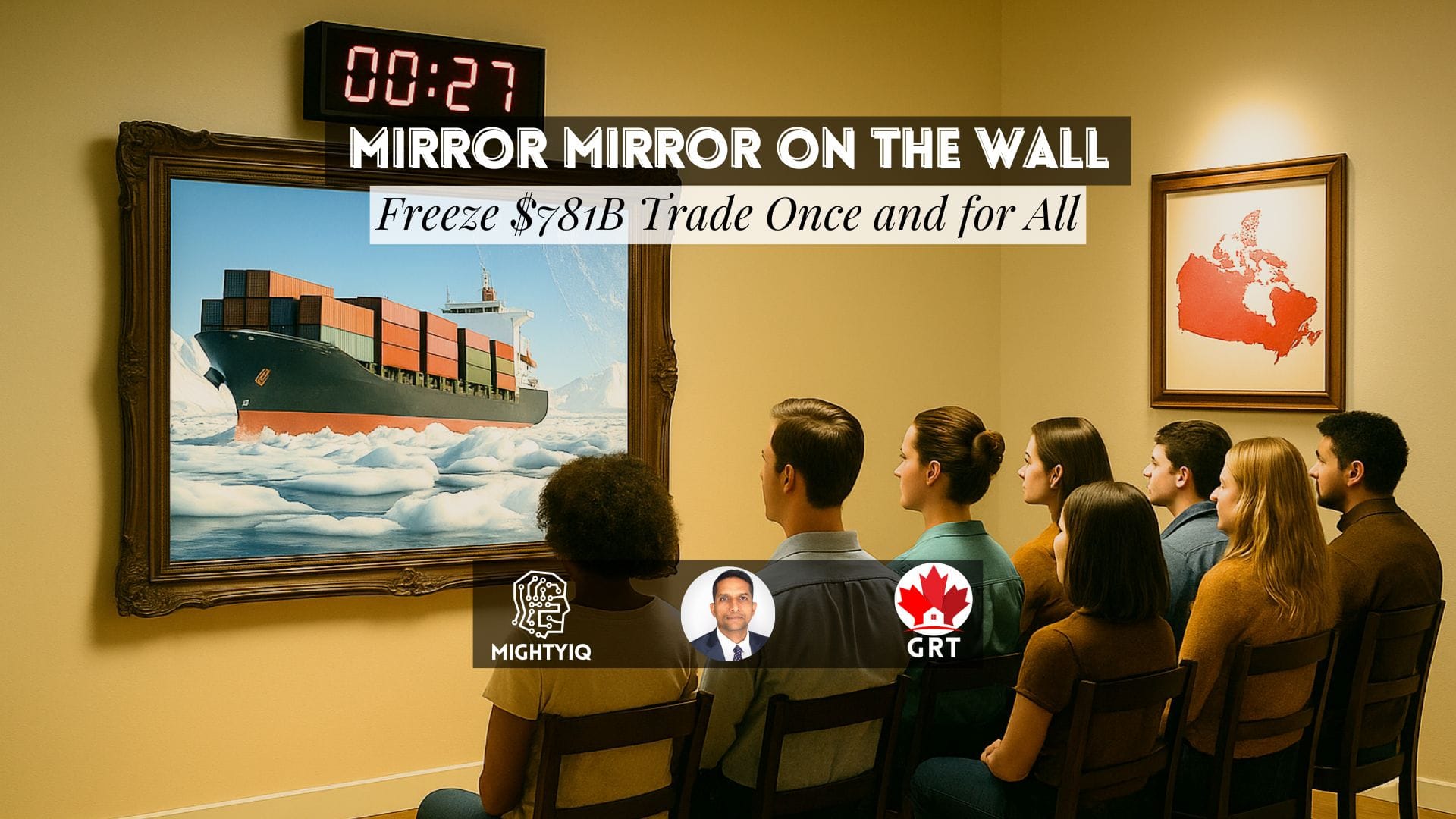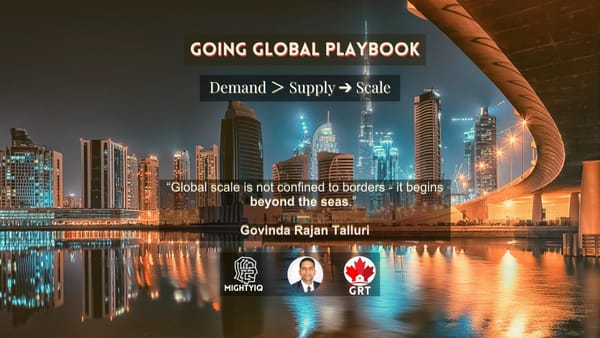Mirror Mirror on the Wall
In global trade, it doesn’t take a policy to freeze momentum — sometimes, just a 60-second ad.
Here’s how $781 billion in commerce went on ice overnight. ❄️
The 60-Second Shock That Stopped $781B in Motion
On October 25, 2025, the U.S. announced a new 10% tariff increase on Canadian imports — raising the total tariff on most affected goods from 35% to 45%.
The move came after a television ad funded by Ontario aired during the World Series, criticizing U.S. tariffs using a Ronald Reagan speech.
What began as a clever piece of political commentary quickly spiraled into an international trade incident.
President Donald Trump called the ad “egregious and misleading,” labeling it a “hostile act” designed to influence a Supreme Court case on tariffs. Within hours, he declared:
“All trade negotiations with Canada are hereby terminated.”
The new tariffs hit almost every major export category — except a few energy and potash commodities, which remain at 10%. Steel and aluminum now face a punitive 50% tariff.
Prime Minister Mark Carney responded firmly:
“Canada is prepared to talk when the U.S. is ready — but not at any cost.”
Talks that had shown progress on steel, aluminum, and energy are now frozen indefinitely.

What Changed in 2025
The latest escalation didn’t come out of nowhere. It was a slow build — one policy speech, one tariff adjustment, one campaign message at a time.
📉 Tariffs Returned as Political Tools
After the 2025 midterms, Washington quietly reinstated selective duties on metals, autos, and processed goods, branding them as “worker protection” measures. Tariffs became a rallying cry for domestic manufacturing rather than a negotiation lever.
🪙 Investment Became One-Way
Canada’s pledge of $1 trillion in investment into the U.S. was pitched as partnership, but little flowed in reverse.
Washington focused on domestic capital formation, while Ottawa sought stability through access — a dynamic that now looks one-sided.
📺 Optics Replaced Outcomes
For much of 2025, bilateral meetings were labeled “positive,” but tangible results were scarce. The Ontario ad didn’t create the conflict — it merely exposed how fragile the “positive optics” truly were.
🌎 Global Context Tightened
With U.S. trade walls rising against China, Europe, and now Canada, the message is simple: diversify or depend.
The post-pandemic trade order is shifting toward regional self-interest, and Canada — like many mid-sized economies — is caught in the recalibration.
The 77% Exposure
In 2024, Canada exported $781 billion in goods — 77% went to the United States.
That’s not just concentration. That’s strategic dependency.
| Sector | % to U.S. | Diversification Status |
|---|---|---|
| Energy Products | 89% | Highly dependent |
| Automotive | 85–90% | Highly dependent |
| Plastics & Chemicals | 75–85% | Highly dependent |
| Pharmaceuticals | 70–80% | Moderately dependent |
| Agriculture | 30–40% | Most diversified |
| Metals & Minerals | 50–60% | Moderately diversified |
| Critical Minerals | 60% (declining) | Rapidly diversifying |
When one buyer dominates your export book, every headline becomes a market signal — and every policy speech, a potential disruption.
The Real Lesson: Dependency Is Not Diplomacy
Canada’s challenge isn’t geography — it’s optionality.
The country’s trade architecture still points south by design, not by strategy.
The antidote lies in diversification — not slogans, but infrastructure.
🏗️ Build LNG Terminals and Ports
Ports that connect to Europe and Asia aren’t luxuries — they’re economic insurance.
Western Canada’s LNG and Atlantic terminals can become the arteries of trade independence.
🤝 Activate CETA and CPTPP
Canada already has tariff-free or reduced access to over a billion consumers across Europe and the Asia-Pacific.
The problem isn’t access — it’s activation. SMEs need funding, market intelligence, and export financing to leverage these corridors.
⚙️ Move Up the Value Chain
From crude to fuel, lumber to engineered wood, canola to packaged foods — value-added production multiplies leverage.
Selling finished products, not raw materials, transforms price-takers into price-setters.
🔋 Invest in Critical Minerals Refining
Canada holds what the world needs — lithium, cobalt, nickel, and copper.
Refining them domestically creates jobs, sovereignty, and negotiating power in the EV and clean-tech supply chain.
What I’m Watching
👉 How quickly Canada can turn diplomacy into direction — redirecting trade missions and financing toward Asia and Europe.
👉 Whether Canadian SMEs step off the comfort path — exploring new markets beyond the U.S. corridor.
👉 If Ottawa moves from rhetoric to real spending — on ports, processing, and export infrastructure that enable diversification.
👉 And when “Made in Canada” finally evolves into “Marketed Globally.”
The Closing Play: The Optionality Imperative
Power in trade doesn’t come from goodwill — it comes from choices.
When Canada can say:
“Our LNG sails to Europe.”
“Our minerals power Asian EVs.”
“Our trade agreements rival U.S. market access.”
— then Washington will negotiate from respect, not reliance.
Optionality is the new sovereignty.
And this 60-second ad — however unintended — may have just handed Canada the mirror it needed to see that clearly.
🔔 Beyond Growth Takeaways
✅ 77% dependence is not stability — it’s exposure.
✅ Build the infrastructure that opens new trade lanes.
✅ Leverage existing agreements like CETA & CPTPP.
✅ Add value before export — own the premium.
✅ Play the minerals card strategically.
✅ Don’t wait for politics — build options first.
💬 Your Take?
Did a 60-second ad just expose a 30-year vulnerability — or ignite Canada’s moment to redefine its trade future?
🤝 Let’s Collaborate
I’m a Canada-based entrepreneur and business growth consultant working at the intersection of trade, media, and technology — helping companies navigate disruption and convert uncertainty into opportunity.
My focus: guiding organizations to diversify markets, strengthen positioning, and build sustainable growth — whether through exports, digital platforms, or product innovation.
What I help with:
🌍 Trade & Market Diversification — unlocking new geographies, designing smarter trade routes, and reducing overdependence on single markets.
🛒 CPG Strategy & Consumer Insights — aligning product, pricing, and value with changing global demand patterns.
📺 Media & Digital Transformation — enabling content, FAST channels, and digital platforms to reach audiences and monetize effectively across borders.
Across industries — from wellness to entertainment — the winners aren’t waiting for the next policy shift.
They’re building optionality, blending value with innovation, and shaping the future before it’s decided for them.
🌐 Building something new?
If you’re looking for a reliable hosting provider, I’d recommend DreamHost.
We’ve used it for our client websites for over a decade — it’s fast, secure, and built for creators who want peace of mind.
🔔 Stay Connected
If this story of resilience, diversification, and reinvention resonates with you, let’s continue the conversation.
👉 Subscribe to my newsletter on entrepreneurship, media, AI, and global trade strategy: iamgrt.kit.com
Disclaimer: Visual generated using AI and editing tools.



